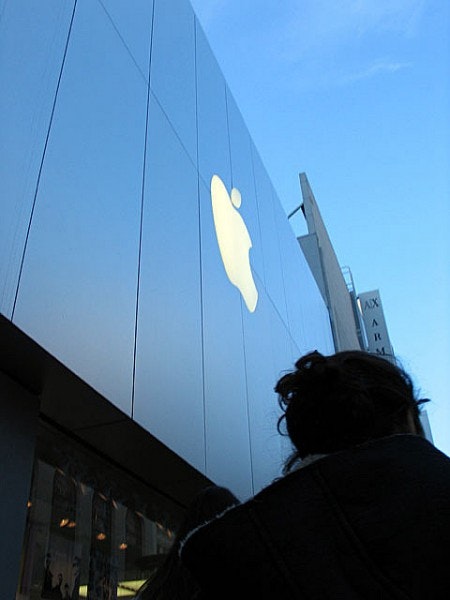Apple Inc. (NASDAQ: AAPL) has recently upgraded its little desktop box, the Apple TV, but the changes were all internal so there was little fanfare. At $99, the 5 million units sold last year provided just a drop in the $165 Billion (ttm) revenue bucket. So what is point here? Does the upgrade have any real significance for the investor?

1. I think the Apple TV plays an important part in Apple Inc. (NASDAQ: AAPL)’s overall strategy, and
2. It may be that this little upgrade points to a new, upcoming product.
1 – What is the Apple TV?

The Apple TV is a little set-top box that connects to your HD TV/Home Theater, and to your internet (via Ethernet or Wifi) and provides for the delivery of content to the entertainment system. Content sources include:
- Your iTunes music delivered to your stereo,
- Your iTunes stored videos (i.e. personal or purchased),
- Videos rented in iTunes,
- Your photos shared from iPhoto
You can also display content from:
- Netflix, Hulu +, YouTube, Vimeo, Flickr,
- MLB, NBA, NHL,
- WSJ
- others to come…?
Finally, with the AirPlay feature, you can display anything at all from your iOS device or Mt. Lion OS Mac on the screen. So any website you can access can be displayed, or any other content you may have.
They seem to be popular with a 4 ½ star rating on Amazon (about as high as you can get in electronics). While Tim Cook’s assessment of the device might be taken with a grain of salt, blog commenter Fkung writes:
We have two Apple TV box in our homes and we love the device. Using these devices, we can access bbc news, CCTV and many other program.
We can now see our photos, videos on the big screen HD TV at home. In fact all our friends and visitors love them when I demonstrate the capability of Apple ecosystem. many have been converted and are now proud and satisfied owners of iPhone, iPad, Mac and Apple TV!
And TimProtech adds:
Best $100 bucks we ever spent. It easily allowed me to cut the cable, saving me $100 every month! I’d say that’s a pretty good ROI.
2 – Why does it matter?
Well, only Apple Inc. (NASDAQ: AAPL) can shrug off a half-billion dollar business as a “hobby,” but the device has an importance aside from the income.
Apple TV plays a very important role in Apple’s strategy. We need to remember, Apple Inc. (NASDAQ: AAPL) does not consider itself a Hardware company anymore – rather a Service company. Its products are not the physical devices, but the user experience that these provide. This, indeed, is what has driven people to flock to their products. (This is admittedly a bit simplistic a view – as are most “either/or” dichotomizations. We all know that the products themselves are designed to please in their own right, but still it is generally valid.)
So the Apple TV plays this very important role in making sure that the content available via iTunes and on one’s Mac or iOS device can be reliably sent to a home entertainment system. Additionally, it does so with Apple’s uniquely simple and elegant interface.
3 – What were the changes?
The folks at Anand Tech have done a great techie review of the device, and they noted two changes:
1. Circuit board layout changes (including new auxiliary chips), and
2. A new version of the A5 chip.
All changes seem to be helping to reduce costs, but number 2 is the more significant one.
The A5 System-on-a-Chip (SoC) chips that are used in the iPad 2 and iPhone 4S, include dual-core CPUs, (Essentially, they are almost like having two central processing units.) The Apple TV does not need all this power, so it ran the original A5 with one core disabled. This would help reduce fabrication production loss, since frequently, a wafer has a certain number of flaws, and these flawed processors could still be used. But once you need a quantity higher than the natural error rate, you begin using “good” dual-core processors for your restricted needs. Wasteful. Let’s face it, 5,000,000 is a pretty large number of units!
So Apple Inc. (NASDAQ: AAPL) went out and made a new version of the A5 especially for the Apple TV, one designed with a single core.
The chip is therefore smaller, which means you get more per wafer off the fab line, yielding lower cost. It does not cost to produce a single chip, rather to make a wafer. If you get more product per wafer, you have lower per-unit cost. Fine and dandy, we have just contributed a 1/100thpercent to the gross margin.
But there is another significant change here. The incredible folks at Anand Tech. were not content at this, but went on to explore the possibility that the power consumption of the chip had improved. Their analysis shows that there indeed was a very significant power savings in the new chip – 40-50% in the various operating scenarios.
The article Apple – Apple TV & iPhone Mini Speculation originally appeared on Fool.com and is written by Malcolm Manness.
Copyright © 1995 – 2013 The Motley Fool, LLC. All rights reserved. The Motley Fool has a disclosure policy.
